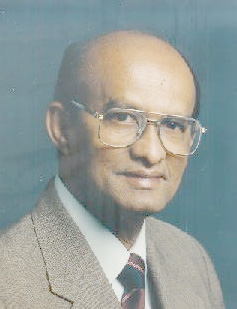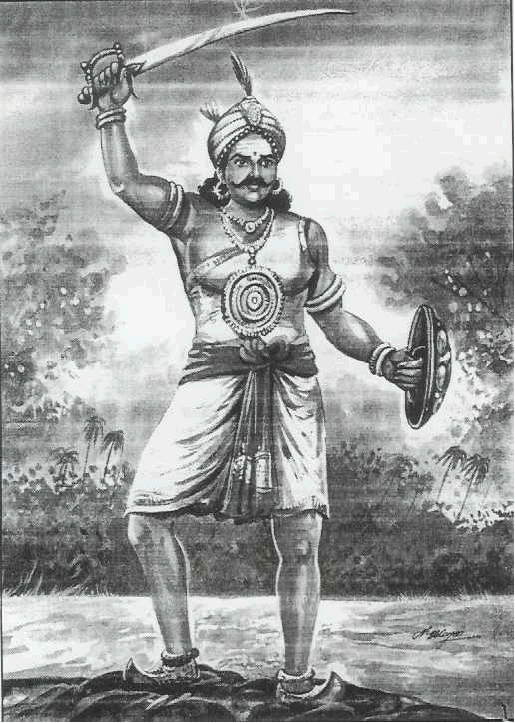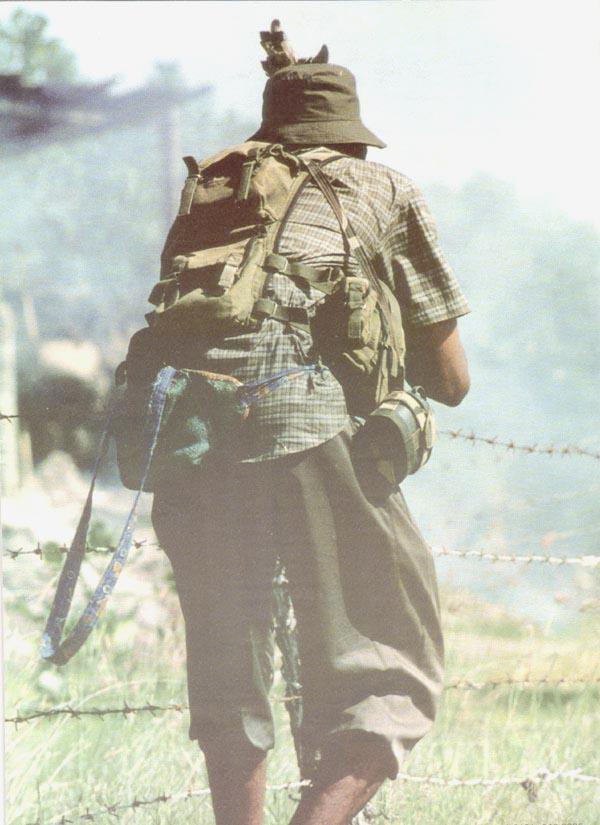|
TAMIL
NATION LIBRARY: Eelam
 S.
Makenthiran is a graduate of the University of Ceylon, Colombo and a
Fellow of the Chartered Association of Certified Accountants of UK.
He has served in Sri Lanka and different countries in Africa
including Zambia, Malawi and Botswana. He was a World Bank Project
Finance Officer, before immigrating to Canada. S.
Makenthiran is a graduate of the University of Ceylon, Colombo and a
Fellow of the Chartered Association of Certified Accountants of UK.
He has served in Sri Lanka and different countries in Africa
including Zambia, Malawi and Botswana. He was a World Bank Project
Finance Officer, before immigrating to Canada.
 Book Review
Book Review
 From the Preface
From the Preface
 Table of Contents
Table of Contents
 Full Text in PDF
Full Text in PDF
|

Maaveeran Pandara Vanniyan
Last Tamil King of Vanni
(1777 � 1811) |
Book Review by
Paraskthi Sundharalingam -
History in a Nutshell
I read with interest, the book about the sad history of the
Tamils in Sri Lanka by Mr. S. Makenthiran of Canada. This book of
187 pages titled �Tamils in Independent Ceylon� narrates our history
from the time Ceylon was granted independence to the suspension of
peace talks. The author has also briefly referred to the people, who
inhabited Ceylon from prehistoric times. He has condensed modern
Ceylon Tamil history in a clear and concise manner covering many
aspects.
When volumes are written these days by academics, documenting the
struggle of Sri Lankan Tamils to live with self respect in their
homeland, this little book stands out. There is brevity in the
writing, the language is simple, and the style lucid. He begins the
story with nostalgia thus:
�My memory comes back to me as I sit here as a retired
accountant in Canada, living in the past when Ceylon was quiet
and peaceful�.
As an experienced man. and a keen historian and journalist, the
author has an eye for detail and presents facts well. There is fact
and no fiction in his writing.
The book presents a true picture of the history of Ceylon, that has
been distorted, and many facts suppressed by interested parties. He
recollects the peaceful co-existence that existed among the
different communities before the racial venom began to poison the
minds of the majority Sinhalese after independence. As one who lived
through the events, he has given a clear picture of the
massive
colonisation of the traditional Tamil homeland by the Sinhalese
, and the
imposition of the �Sinhala Only Act�, followed by the anti-Tamil
racial violence. We hear the
anguished cry of the veteran journalist Tarzi Vitachi in his
writing �Have the Sinhalese and Tamils reached the parting of the
ways�. The events that unfolded later gives credence to his views.
The author has devoted chapters to each of the three great Tamil
leaders in independent Ceylon �
S.J.V.
Chelvanayagam,
Sauvyamoorthy Thondaiman, and
Velupillai Prabaharan. In particular, the contributions of
S.J.V. (Thanthai Chelva) and Prabaharan, the Hero of Tamil
Liberation, in uniting the Eelam Tamils under one banner deserves
praise. �United we stand; divided we fall�
The author details the
futile agitation by the Tamil leaders through peaceful means for
nearly 30 years to regain their lost rights. The treachery of D.S.
Senanayake, the cunningness of J.R. Jayawardene, the highhandedness
of the Bandaranayakes and the deceit of Premadasa led to the present
state of things. It is only after the failure of peaceful agitation,
the Tamil youth
took to arms to defend their beleaguered people as a last
resort. The book describes the forced mass exodus of the Tamils,
first from the highlands and then from the Northeast. It highlights
the unprecedented and racially motivated depriving of the
upcountry Tamils of their civic rights by the majority Sinhalese in
the very year of independence.
The writer rejects the description of S.J.V. by a Sinhalese leader
�as a lean and hungry looking man who cannot be trusted�. When the
great Tamil leader, handsome as a young man, became frail due to
failing health, the writer aptly states �May be the responsibility
of leading a persecuted people against heavy odds, weighed heavily
on him�.
 When
Tamil leadership passed on to the Tamil militants, he justifies it
appropriately. �The Tamils suffering under Sinhalese terrorism and
helpless against state oppression needed a leader, and that leader
came in the person of Velupillai Prabaharan�. The legendary exploits
of the Tamil Tigers against the Sri Lankan armed forces are
described here as a sacred fight for the freedom of their homeland.
The author�s continuous reference to the freedom struggle with the
epithet �sacred�, explains the rationale behind this struggle, and
the author�s feelings for Tamils denied their rights. When
Tamil leadership passed on to the Tamil militants, he justifies it
appropriately. �The Tamils suffering under Sinhalese terrorism and
helpless against state oppression needed a leader, and that leader
came in the person of Velupillai Prabaharan�. The legendary exploits
of the Tamil Tigers against the Sri Lankan armed forces are
described here as a sacred fight for the freedom of their homeland.
The author�s continuous reference to the freedom struggle with the
epithet �sacred�, explains the rationale behind this struggle, and
the author�s feelings for Tamils denied their rights.
The historian in him, compares the
landing at Kudarappu to the
Normandy landings in World War 2, and the
capture of Elephant Pass
to
General Giap�s spectacular victory against the French in Vietnam.
While describing the
Katunayake debacle, he quotes military analysts, who describe it
as the most devastating attack in aviation history. There is awe and
admiration for the Tamil Tiger martyrs. To him, Prabaharan is
Zhukov in Stalingrad and
Ho Chi Minh in
Dien Bien Phu, when the tide of Eelam war was turned, by
destroying the mighty Sri Lankan military machine with meagre
resources.
The author�s love for his people, his agony and helplessness in
watching �Paradise Lost� is visible in this honest narration. He
demolishes casually, the absurd notion of some Sinhalese people,
that they are the original Aryan inhabitants of Ceylon and that the
Dravidian Tamils came much later. Effortlessly, he explains that it
is nothing but common sense that when India and Ceylon was one mass
of land geographically and later separated by the eroding sea, the
people living on the land thus cut off would have been Tamils! When
Vijaya and his friends arrived later without any women, they would
have obviously married local women who were Tamils. Are we to
believe that Indian Tamil fishermen who lived just across the Palk
Strait
did not see Ceylon till Vijaya came and �discovered� it in the 6th
century B.C.
Makenthiran�s writing is balanced, which comes from his long
experience and knowledge of history. He understands the present, and
foresees the future from his experience of the past. Above all, he
is a good human who yearns for peace. This book is a must for
everyone interested in the sacred fight for self-respect, and to the
younger generation in particular.
 Preface
Preface
Living in retirement, I thought that it would be a good idea to
record my impression of our people�s history during my lifetime.
Though I am an accountant by profession, history has been my
passion. I believe Tamils, particularly the younger generation,
will be interested in their roots and our kith and kin, whom we
have left behind in mother Eelam.
This book is a revised
version of the series of articles I wrote for Ceylon Times. I am
narrating the history of Tamils in independent Ceylon (now Sri
Lanka), including the Upcountry Tamils who arrived in the 19th
century, and are ethnically the same. I am also including the
Tamil-speaking Muslims, as they speak the same language and are
therefore, strongly bound to the Tamils, but are culturally
different and follow a different religion. As far as the Tamil
Christians (Catholics and Protestants) are concerned, they are
no different from Hindu Tamils, except that they follow the
Christian religion.
The history of Lanka has been
distorted and many facts suppressed by interested parties. I
have written using my knowledge and experience, and the
information from the meagre sources available to me. I have
briefly touched on the history of Ceylon Tamils from the time
Lanka was connected to India by land, and the Great Tamil Hindu
King Ravanan, who ruled over all Lanka thousands of years ago. I
have covered the struggle of the Tamils after independence up to
the cease-fire and peace talks.
S. Makenthiran, October
2004,
Mississauga,
Canada
 Table of Contents
Table of Contents
Chapter 1: Ceylon Independence
The dawn of Independence
Paradise gained and lost
Ceylon Tamils, the original inhabitants
Immigrants to Ceylon
Chapter 2: Ceylon on the eve of colonialism
Childhood recollections
My recollections of early politics
Second World War recollections
Teenage recollections
Recollections as an undergraduate
Chapter 3: Political developments up to independence
Ceylon as a British colony
Sir Ponnambalam Ramanathan
G.G. Ponnambalam
Sinhala Muslim riot of 1915
Sinhaleses
prior to independence
Muslims in Ceylon
The Upcountry
Tamils
The Ceylon Tamils
Chapter 4: Political developments after independence
The Sinhalese dominated UNP comes to power
The great
betrayal of Upcountry Tamils
Tamil agitation
Sinhala
colonisation of Tamil homeland
Sinhala Only act
Sinhala
violence against the Tamils in 1956
The
Bandaranayake-Chelvanayagam Pact dishonoured
Sinhalese
massacre Tamils in 1958
Chapter 5: Events leading to Tamil Eelam
demand
Srimavo continues the anti-Tamil policies
Attempted coup
Srimavo-Shastri Pact
Senanayake-Chelvanayagam Past dishonored
Ceylon renamed Sri
Lanka
Tamil students discriminated
The JVP insurrection of
1971
The War of Bangladesh Liberation
Police violence
against the Tamils
The formation of the Liberation Tigers of
Tamil Eelam
The Vaddukkoddai Resolution for Tamil Eelam
Anti-Tamil racial riot of 1977
Tamil youth answer the call of
Thanthai Chelva
Chapter 6: The Father of the Tamil Nation
Early
years
S.J.V.�s family
Entry into politics
Federal Party
Peaceful protests under Thanthai Chelva
Tamil United
Liberation Front
Demise of the great leader
Chapter 7: Vaddukoddai Resolution
Chapter 8 Tamil
youth react to Sinhala terror
Tamil militancy
Another constitution introduced
Burning of the Jaffna library by the police
Anti-Tamil
hostility
Sporadic attacks by Tamil youth intensified
Arbitrary arrests of Tamils
Chapter 9: The 1983 genocide of Tamils by Sinhalese
The ambush at Tinnevely
The Sinhalese massacre Tamils
Chapter 10: Aftermath of the holocaust
Sixth
Amendment to the Constitution
Unitary and federal
constitution
Jayawardena government further alienates Tamils
Tamil militancy gathers strength
Sinhala �Veerayas�
Plan
to separate Northern and Eastern Provinces
The Tamil exodus
Chapter 11: The Eelam War I
Beginning of the Eelam
Wars
Guerrilla attacks
Sinhala atrocities
Cease-fire
and Thimpu Talks
Sinhala state terrorism continues
Women
in LTTE
Lieut. Colonel Ponnamman and Yogaratnam Yogi
Vijaya Kumaratunga
Appapillai Amirthalingam
The Black
Tigers
Chapter 12: The Patriarch of Upcountry Tamils
Early
life
Entry into politics
Upcountry Tamils deprived of
citizenship and franchise
Jaffna Tamils fail Upcountry
brethren
Agitation against Sinhala racism
Renaming to
Ceylon Workers Congress
Srimao-Shastri Pact
The champion
of orphaned people
Eviction of estate Tamils
Common
suffering of Northeast and Upcountry Tamils
Triumvirate of
TULF leaders
Re-entry into Parliament
Thondaman extracts
concessions
Northeast rebellion helps Upcountry Tamils
State funeral
Chapter 13: The IPKF War
Operation Liberation
Air
drop and talks
Indo-Sri Lankan Accord
The Thirteenth
Amendment to the Constitution
Death fast by Dileepan
Death
of twelve LTTE commanders
Operation Pawan
Northeast
Provincial Council
LTTE fights back
The second JVP revolt
President Ranasinghe, cease-fire and talks
Deparure of the IPKF
Chapter 14: Eelam War 2
President Premadasa requests IPKF withdrawal
Cease-fire and
talks
Talks fail
Hostilities break out
Tamils massacred
by army and Muslims in the East
Battle for Jaffna Fort
Assassination of Rajiv Gandhi
The Battle for Elephant Pass
Assassinations
Assassination of Premadasa
Mathaya
(Mahendraraja)
War continues
Chandrika Kumaratunga takes
over
Chapter 15: Eelam War 3 begins
Chandrika assumes
power
Peace talks
Gamini Dissanayake assassinated
Eelam
War 3 breaks out
Operation Leap Forward
Proposal for
devolution
Bomb attacks in Colombo
Operation Riviresa (Sun
Rays)
Unceasing Waves 1
Operation Jayasikuru (Victory
Assured)
Unceasing Waves 2 and 3
Chapter 16: The liberation of Mullaitivu
Tamil
ancestral district of Mullaitivu
The rape of Mullaitivu
Operation Unceasing waves
Mullaitivu liberated
Casualties
The prize of war
Inexorable LTTE advance
Chapter 17: The liberation of Vanni and Elephant Pass
Prabaharan prepares for the counter offensive
Unceasing
Waves 2
Unceasing Waves 3
The liberation of Vanni
The
capture of Elephant Pass
Tigers advance on Jaffna Town
Anton Balasingam�s illness
Massacre of Tamil children by
Sinhalese mobs
Killing of Tamil journalist Nimalarajan
Prabaharan declares cease-fire
Chapter 18: The Hero of Tamil Liberation
The son of the people
The legendary hero
Early years
Marriage and family
Consolidation by Prabararan
The Indian
factor
Retreat to Vanni and counter attack
Road to victory
Battle hardened veteran
Prabaharan offers peace
Chapter 19: The Agni Keela and Katunayaka debacles
Debacles in 2001
Agni Keela
Surprise offensive
Tamil
women repulse Sinhalese army
Katunayaka debacle
Anniversary of 1983 Black July
The attack
Colossal damage
Sinhalese propaganda
Chapter 20: Leaders of Tamil speaking people
Tamil
leadership developments
Collaborators
Muslim leadership
�Mamanithar� Kumar Ponnamblam
Murugesu Sivasithambaram
Rajavarothayam Sambandan
Anton Balasingam
Chapter 21: Cease-fire
Cease-fire
Peace talks
Suspension of Talks
Reactions to suspension
Efforts to
resume talks
SL Government�s proposals for NE Interim
Administration
LTTE Paris meeting
LTTE proposals for
Interim Self-Governing Authority
Chapter 22 Interim Self-Governing Authority
Chapter
23 Coup by President Chandrika
Reactions to the LTTE proposals
President Chandrika
seizes ministries
Chandrika checkmated
Reactions to
Chandrila�s power grab.
Political stalemate
Budhist
violence against Christians and Muslims
United Peoples
Freedom alliance
Tamil reaction to new alliance
Chapter 24: Betrayal of the LTTE by Col. Karuna
The
rise of Karuna
The revolt
The fall of Karuna
The causes
of Karuna�s debacle
Chapter 25: The future of Ceylon Tamils
President
Chandrika appeals to the Norwegians
Changes in the Indian
political scenario
Tamil hopes for the future
|